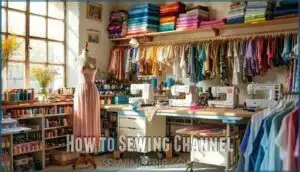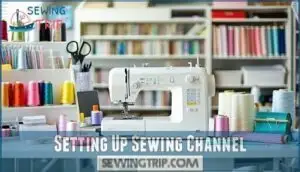This site is supported by our readers. We may earn a commission, at no cost to you, if you purchase through links.

Focus on structured tutorials with step-by-step instructions and project walkthroughs that build viewer confidence. Plan interactive content including live streams and Q&A sessions to engage your community. Master your techniques and develop an authentic teaching personality before hitting record.
The real magic happens when you discover the monetization strategies that transform your passion into profit, using techniques from successful channels and creating content like structured tutorials and live streams to build a community around your sewing channel.
Table Of Contents
Key Takeaways
- Choose your niche early – You’ll attract a stronger audience by focusing on one specialty, like beginner garments or sustainable upcycling, instead of scattered content across multiple areas.
- Start with basic equipment and consistency – You don’t need Hollywood production quality; focus on clear explanations, consistent lighting, and regular posting schedules to build viewer trust.
- Create structured, step-by-step tutorials – Your viewers want practical skills they can follow along with, so break down complex projects into digestible segments that build confidence.
- Diversify your income streams – You’ll maximize earnings by combining YouTube ad revenue, affiliate links, sponsored content, paid online classes, and Patreon memberships rather than relying on one source.
Sewing Channel Overview
You’ll find sewing channels like WPSU’s Create offer weekend quilting shows, though most episodes are older reruns from the 2000s.
Understanding current programming helps you identify gaps in the market before launching your own channel, which can be a key factor in making your channel successful.
Create Channel Programming
Exploring Create channel programming reveals a treasure trove for sewing enthusiasts. Pennsylvania’s WPSU Schedule features dedicated Saturday sewing content, though Program Repeats from 2010 dominate the lineup.
This Content Variety includes cooking, travel, and politics throughout the week. Regional Variations exist across states, affecting Viewer Access to quality sewing tutorials and video content.
Many sewists find inspiration in online sewing communities for collaborative learning, which is a key part of the sewing enthusiasts community.
WPSU Channel Availability
You’ll find WPSU through your Comcast cable provider in Pennsylvania, but this public TV channel isn’t available nationwide.
Each state operates its own PBS station with regional variations in programming and channel lineup.
- Comcast Access – Pennsylvania subscribers get direct channel access through their cable package
- State Restrictions – Content varies by location, so your neighbor in Ohio won’t see identical programming
- PBS Availability – Contact your local PBS station to confirm Create channel offerings in your area
- Regional Variations – Different states feature unique educational content adapted to local audiences
Viewers can explore various sewing projects online to enhance their crafting skills.
Sewing Quilting Program Details
You’ll discover that sewing quilting programs on Create channels offer repeats from earlier decades, with many episodes dating back to 2001 and 2010.
These Saturday-only broadcasts focus on traditional sewing techniques, quilting patterns, and fabric choice guidance.
While newer sewing tutorials aren’t common, these classic sewing classes provide solid quilting education and time-tested sewing tips for your channel inspiration.
How to Sewing Channel
Starting your sewing channel begins with understanding your craft inside and out. You’ll need solid sewing techniques and a genuine passion for sharing knowledge with others.
Master your fabric choice decisions, thread selection process, and pattern making skills before hitting record.
Your success depends on three fundamental elements:
- Technical expertise – Know your sewing tools, understand different sewing patterns, and practice various sewing techniques until they’re second nature
- Teaching ability – Break down complex sewing projects into digestible steps that beginners can follow
- Authentic personality – Let your unique perspective shine through each tutorial.
You don’t need Hollywood-level production quality to start. Many successful creators began filming sewing tutorials on their kitchen tables with basic cameras.
Focus on clear explanations and helpful sewing tips rather than perfect lighting. Your viewers want to learn practical skills, not watch a polished commercial.
Remember, every expert was once a beginner. Share your learning journey, including mistakes and discoveries. This honesty builds trust with your audience and makes your sewing classes more relatable and valuable.
Understanding sewing basics is essential for creating engaging and informative content that resonates with your audience.
Setting Up Sewing Channel
Before you can start filming tutorials, you need to establish a solid foundation for your sewing channel.
Setting up the technical and creative framework properly from the beginning saves you countless headaches and helps your channel grow faster than trying to fix mistakes later, which is crucial for a solid foundation.
Clear Niche Selection
Success hinges on choosing your battlefield wisely.
Your sewing niche choice shapes everything—from content creation to community building success.
Focus your sewing channel on one specialty—whether it’s beginner-friendly garment construction, advanced tailoring techniques, or sustainable upcycling projects.
This targeted approach builds stronger brand identity and attracts your ideal sewing community more effectively than scattered content.
A well-organized workspace, including a dedicated sewing room setup, is essential for productivity and creativity.
| Niche Focus | Target Audience | Content Examples |
|---|---|---|
| Beginner Garments | New sewers, hobby enthusiasts | Basic seams, simple patterns, troubleshooting |
| Advanced Tailoring | Experienced crafters, professionals | Complex construction, fitting techniques, couture methods |
| Sustainable Upcycling | Eco-conscious makers, budget sewers | Refashioning tutorials, scrap projects, thrift flips |
| Quilting Mastery | Traditional quilters, pattern lovers | Block techniques, binding methods, design principles |
Dedicated Filming Area
Beyond your sewing table, establish a dedicated filming space with consistent lighting setup and backdrop options.
Position your camera at multiple angles to capture detailed hand movements and full project views.
Create an equipment list including tripods, ring lights, and neutral backdrops that complement your sewing room’s aesthetic.
Your sewing studio becomes your stage for teaching others, and investing in proper ring light kits can substantially enhance video quality with the right equipment.
YouTube Account Setup
Setting up your YouTube account marks the beginning of your Channel Creation journey.
Configure Account Settings with your channel name, description, and contact information to establish credibility.
Focus on Branding Strategy by designing consistent logos and channel art that reflect your sewing niche.
Optimize your channel for discoverability through strategic keyword placement in your bio and channel sections.
Researching Successful Channels
Analyzing top YouTube channels reveals game-changing insights for your sewing empire.
Study HelloSewing, Made to Sew, and SewVeryEasy to decode their success formulas through channel analysis and viewer engagement patterns.
- Content Calendar strategies from successful creators show consistent posting schedules
- SEO Optimization techniques help channels like Made Everyday reach broader audiences
- Audience Feedback from Create channel viewers guides content direction for sewing video content
Effective social media presence requires understanding of social media marketing to grow your sewing channel.
Sewing Channel Content Strategy
Your content strategy determines whether viewers stick around or click away after the first few seconds.
Master your first impression or lose viewers forever
Focus on creating structured tutorials that build skills progressively, mix in trending projects that capture search traffic, and add interactive elements like sewing challenges to keep your community engaged.
Structured Tutorials
Tutorial Planning transforms scattered ideas into polished sewing education content that viewers actually finish watching.
You’ll create detailed outlines covering fabric selection, pattern making basics, and essential sewing tips before filming begins.
Video Editing software helps structure your online sewing classes into digestible segments.
Plan each sewing video tutorial with clear learning objectives and step-by-step progressions that build viewer confidence systematically.
Effective sewing business owners understand the importance of creating custom products using sewing business tutorials to enhance their skills and offerings.
They recognize the value of sewing education and polished content in attracting and retaining viewers, which is crucial for a successful sewing business.
Project Walkthroughs
Project walkthroughs showcase complete sewing projects from start to finish, giving viewers confidence to tackle their own creations.
Transform sewing skills into viewer confidence with complete project walkthroughs that guide every step.
You’ll demonstrate fabric choice decisions, pattern making steps, and essential crafting techniques while viewers follow along.
These thorough sewing tutorials work perfectly for complex garments or home décor items that require detailed project planning and multiple sewing tips throughout the process.
Understanding proper sewing machine maintenance is vital for a successful sewing project.
Trend-Based Content
Beyond completing individual projects, you’ll want to capitalize on what’s hot in the sewing world.
Seasonal trends and fashion sewing drive massive viewership when you time content right. Here’s how to ride the trend wave:
- Retro revivals from the 60s-80s create nostalgic engagement
- Sustainable fabric choices appeal to eco-conscious makers
- Pop culture references boost searchability and shares
- Quilting styles merge traditional with modern aesthetics
- Sewing challenges foster community participation
Monitor runway shows, celebrity looks, and social media for inspiration.
Your sewing creativity shines when you interpret high-fashion into accessible tutorials, making sewing design approachable for everyday makers. Staying updated on the latest spring fashion trends helps you create relevant and engaging content for your audience.
Interactive Content
Interactive content transforms viewers into participants through Community Engagement strategies.
Host Live Streams showcasing real-time sewing projects while answering questions. Create Q&A Sessions addressing common technique problems.
Launch User Challenges encouraging followers to share finished projects using your patterns. Establish Feedback Loops by responding to comments and featuring viewer creations in future video tutorials, building loyal sewing communities through interactive content.
Monetizing Sewing Channel
Once you’ve built an audience, you can transform your sewing channel into a profitable business.
Multiple revenue streams from advertising to paid classes will help you earn money while sharing your passion.
Advertising Revenue
YouTube ad revenue becomes your steady income stream once you hit monetization thresholds.
Most sewing channels earn $70-$249 monthly from ads, with higher rates for specialized content like bridal tutorials.
Unlike traditional cable television or Comcast services, YouTube’s video monetization offers global reach beyond local media outlets and television networks.
Sponsored Content
Product placement opens doors beyond traditional ad revenue, letting you partner with brands that align with your sewing community.
Sponsored tutorials featuring specific fabrics, tools, or patterns can generate substantial income while providing valuable content.
Brand partners typically pay $100-1000+ per video depending on your subscriber count and engagement rates.
Affiliate Links
Affiliate marketing transforms your sewing tutorials into steady income streams.
Partner with fabric suppliers and sewing equipment brands to earn commission rates of 2-7% through referral fees.
Use tracking codes to monitor performance and optimize revenue sharing opportunities.
Focus on recommending products you genuinely use in your sewing video recommendations, building trust within your sewing community insights while promoting quality sewing outlets and online sewing resources.
Many sewers also explore a sewing machine affiliate program to diversify their income streams and promote quality sewing outlets.
Paid Online Classes
Teaching paid online sewing courses transforms your expertise into steady income streams. Top sewing instructors earn between $1,400-$8,700 monthly through structured class curriculum and smart pricing strategy.
- Target Audience Research – Identify specific skill levels and sewing interests to tailor your online classes effectively
- Platform Selection – Choose between Teachable, Udemy, or Skillshare based on commission rates and audience reach
- Class Curriculum Design – Structure 2-4 hour courses with downloadable patterns and clear learning objectives
- Pricing Strategy Implementation – Price courses between $19-$120 depending on complexity and included materials
- Marketing Techniques Development – Use email campaigns and social proof to boost online sewing education enrollments
Patreon Memberships
Patreon transforms your sewing tutorials into steady income through Membership Benefits and Exclusive Content.
Popular channels offer 2-5 subscription tiers ranging from $2-$25 monthly, featuring early video access, digital patterns, and behind-the-scenes content.
With 300+ patrons, you’ll earn $850-$2,750 monthly, and focusing on clear Patron Rewards and consistent Creator Support is crucial to build your sewing community.
Frequently Asked Questions (FAQs)
Is there a sewing channel on YouTube?
Yes, there are countless sewing channels on YouTube. You’ll find everything from beginner tutorials to advanced techniques, garment construction, quilting, and upcycling projects to master your craft.
What are the best sewing YouTube channels?
Looking for exceptional sewing instruction? Made to Sew leads with nearly 500,000 subscribers and professional techniques.
WithWendy, Evelyn Wood, and The Essentials Club offer excellent tutorials covering garment construction, quilting, and beginner-friendly projects you’ll actually want to make.
Why should you watch sewing videos on YouTube?
Watching sewing YouTube videos lets you learn new techniques, troubleshoot problems, and master skills at your own pace. You’ll discover creative projects, save money, and join a supportive community.
Where can I find sewing tutorials on YouTube?
A stitch in time saves nine, and YouTube’s your treasure chest.
Search specific techniques like "French seams" or browse channels like WithWendy, Evelyn Wood, or Made to Sew for step-by-step tutorials.
What is a man sewing channel?
A man sewing channel features male creators teaching sewing techniques, garment construction, and fabric projects.
You’ll find tailoring tips, menswear tutorials, and crafting content that breaks traditional gender stereotypes in sewing.
What is a good sewing channel for beginners?
For beginners, "Made to Sew" offers professional techniques with clear step-by-step tutorials.
You’ll find focused camera work, good lighting, and concise explanations without unnecessary chatter that help you master basic skills quickly.
Is there a sewing channel on TV?
Yes, you’ll find dedicated sewing programming on Create TV, which airs craft-focused shows exclusively on Saturdays. It’s available through Comcast in Pennsylvania and other regional PBS affiliates nationwide.
Can I teach myself to use a sewing machine?
You can teach yourself to use a sewing machine with patience and practice.
Start with your machine’s manual, watch online tutorials, and begin with simple straight seams on scrap fabric before tackling real projects.
What sewing programs are on TV?
Over 80% of sewing enthusiasts learn best through visual instruction. You’ll find Create TV channels broadcast sewing and quilting programs exclusively on Saturdays, featuring repeat episodes with techniques and project tutorials.
Is there a masterclass for sewing?
Masterclass doesn’t offer dedicated sewing courses, but you’ll find excellent alternatives through online platforms like Craftsy, CreativeLive, and specialized sewing websites that provide thorough video tutorials and structured learning paths.
Conclusion
Picture your channel transforming from passion project to profitable business empire. Learning how to sewing channel effectively combines creative fulfillment with financial success. You’ve discovered the blueprint: define your niche, create quality content, engage authentically with viewers, and implement diverse monetization strategies.
Your unique voice and expertise will attract a loyal community keen to learn. Start filming tomorrow, stay consistent, and watch your sewing channel grow into the thriving business you’ve dreamed of building. This journey involves create quality content, which is crucial for success.
- https://www.youtube.com/watch?v=WHv9LaP8_6g
- https://beacons.ai/i/blog/sewing-youtubers
- https://www.reddit.com/r/sewing/comments/1dbp9wn/what_are_your_absolute_must_haves_for_sewing/
- https://www.allfreesewing.com/Basics-and-Tutorials/Best-Sewing-Channels-on-YouTube
- https://likesew.com/blog/content-marketing-for-small-business









